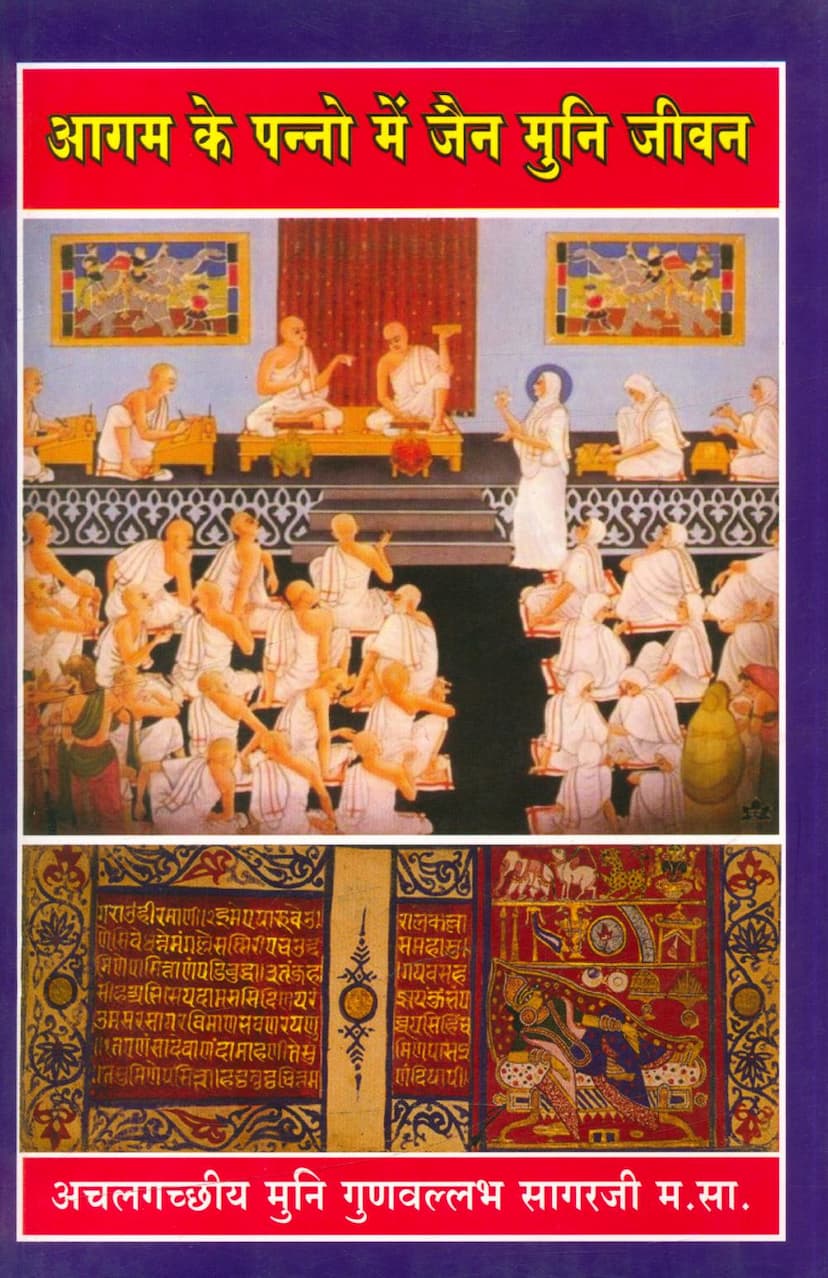Agam Ke Panno Me Jain Muni Jivan
Added to library: September 1, 2025

Summary
Here's a comprehensive summary of the Jain text "Agam Ke Panno Me Jain Muni Jivan" by Gunvallabhsagar, based on the provided pages:
Book Title: Agam Ke Panno Me Jain Muni Jivan (In the Pages of Agam: The Life of a Jain Monk)
Author: Muni Gunvallabhsagar (Achalgachhiya)
Publisher: Charitraratna Foundation Charitable Trust
Overall Purpose: The book aims to compile and present the principles and practices of a Jain monk's life, drawn from the sacred Jain scriptures (Agamas). It seeks to be a guiding resource for monks and nuns to deepen their understanding and adherence to the ascetic path, fostering a more profound spiritual journey and helping them achieve liberation (moksha).
Key Themes and Contents:
The text is structured as a collection of aphorisms and guidelines, derived from various Jain scriptures, offering insights into the ideal conduct, mindset, and practices of a Jain monk. The core themes revolve around:
-
The Importance of Agamas: The introduction emphasizes the Agamas as the mirror to the soul, providing the foundation for all righteous conduct and spiritual advancement. The book's compilation is inspired by the belief that these scriptures hold the key to proper spiritual practice.
-
Path to Liberation: The text repeatedly highlights the progression from knowledge (gyan) to perception (darshan), then to conduct (charitra), leading to liberation (moksha) and ultimately, indivisible happiness.
-
Monastic Conduct and Discipline: A significant portion of the text details the do's and don'ts for monks, covering a wide range of aspects:
- Diet and Asceticism: Emphasis is placed on moderation in food, consuming simple and tasteless food (utsarga marg), the importance of knowledge of quantity and proportion during meals, and practices like unodari (eating less than one's fill) and upavasa (fasting).
- Renunciation and Non-possession (Aparigraha): The text stresses complete non-possession, including detachment from one's own body, and states that monks with possessions are akin to householders.
- Ethical Principles: It covers topics like refraining from backbiting, avoiding hypocrisy, the danger of attachment to worldly pleasures, the importance of Brahmacharya (celibacy), the need to control anger and pride, and the consequences of lying and stealing.
- Conduct in the Community: The text advises on how to handle reprimands from the community, the importance of living harmoniously, and the pitfalls of isolation due to ego.
- Spiritual Practices: It highlights the significance of meditation, contemplation, enduring hardships (parishahas), equanimity, and the study of scriptures (swadhyaya).
- Dealing with Temptations: Specific guidance is given on how to overcome strong desires, particularly sexual urges, through ascetic practices and detachment.
- Purity and Cleanliness: Rules are provided regarding handling utensils, drying clothes, and maintaining a pure environment.
- Respect for Gurus: The importance of respecting and obeying gurus is emphasized, including not exceeding their authority or acting without their permission.
- Mindfulness and Awareness: Monks are encouraged to be mindful of their actions, thoughts, and speech, and to practice awareness in all situations.
-
The Nature of Monastic Life:
- Detachment from the World: The text advises monks to avoid worldly entanglements, such as excessive interaction with householders, royalty, or politicians, as these can disturb their spiritual practice.
- Endurance and Fearlessness: Monks are described as "akutobhayakt" (fearless), able to endure external and internal hardships.
- Physical Austerity: The ideal of becoming physically emaciated through intense penance is mentioned as a means to endure hardships.
-
Scriptural References: The book draws heavily from various Jain canonical texts, including:
- Acharya Sutra (Page 5)
- Sutrakrutanga Sutra (Page 10)
- Sthananga Sutra (Page 15)
- Samvayanga Sutra (Page 15)
- Bhagavati Sutra (Page 24)
- Prashna Vyakarana Sutra (Page 33)
- Antakrida Dashanga Sutra (Page 32)
- Uttaradhyayana Sutra (Page 43)
- Dashavaikalika Sutra (Page 44)
- Oghniryukti Sutra (Page 48)
- Nishitha Sutra (Page 51)
- Brihad Kalpa Sutra (Page 51)
- Vyavahara Sutra (Page 52)
- Jita Kalpa Sutra (Page 54)
- Mahanishiya Sutra (Page 55)
- Pind Niryukti Sutra (Page 61)
- Nandisutra (Page 77)
- Anuyogadvara Sutra (Page 82)
- (And many others implied by the extensive numbering of points.)
-
The Ideal Monk: The text describes an ideal monk as someone who is:
- Knowledgeable in scriptures.
- Disciplined in conduct.
- Detached from worldly pleasures and possessions.
- Fearless and resilient.
- Compassionate towards all beings.
- Devoted to spiritual practices and austerities.
- Respectful of gurus and elders.
- Mindful and vigilant.
-
Specific Rules and Regulations: Many points list specific rules, such as:
- Not accepting items purchased from a shop.
- Not going to the homes of householders who invite them for gochari (alms-round) without specific reasons (like propagating Jainism).
- Drying clothes on the ground, not on ropes.
- Handing back borrowed items by placing them on the ground.
- Not engaging in unnecessary massage or physical contact.
- Not wearing more than three garments.
- The proper way to conduct gochari.
- The prescribed sleep duration for different types of monks.
- The prohibition of certain foods or practices.
-
Philosophical Insights: The text touches upon concepts like anēkāntavāda (non-absolutism) in speech, the nature of karma, the importance of righteous effort (purushartha), and the path to spiritual purification.
Compilation and Intention: The book was compiled during a ten-month stay in Girnarji. The author's intention is to provide a resource that aids monks and nuns in their contemplative study (anupreksha) and the proper cultivation of their spiritual path, ultimately leading to self-upliftment and the shedding of karma.
In essence, "Agam Ke Panno Me Jain Muni Jivan" serves as a comprehensive manual and devotional compilation, offering profound guidance on the rigorous yet rewarding path of a Jain monk, grounded in the ancient wisdom of the Agamas.